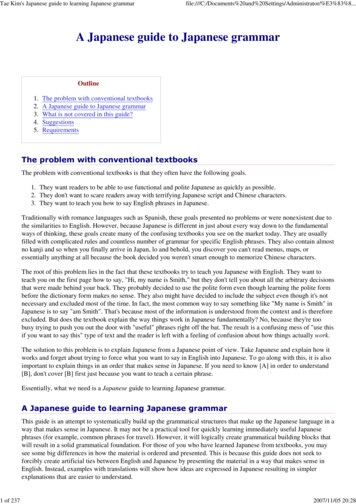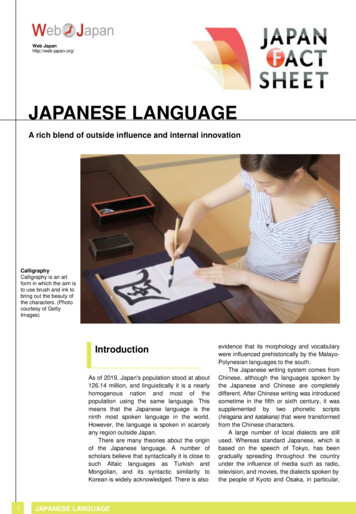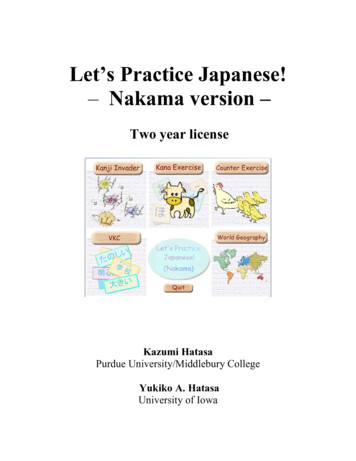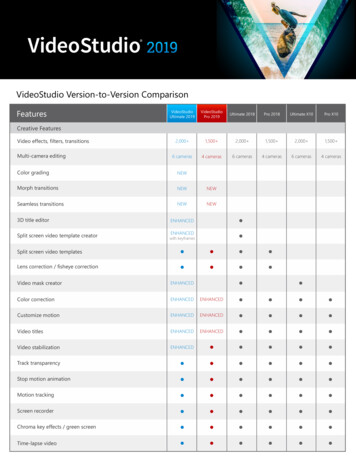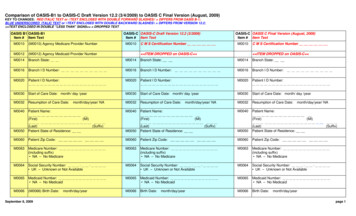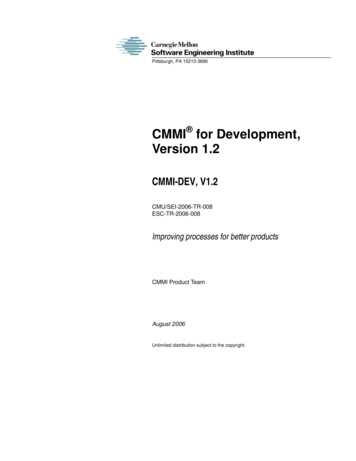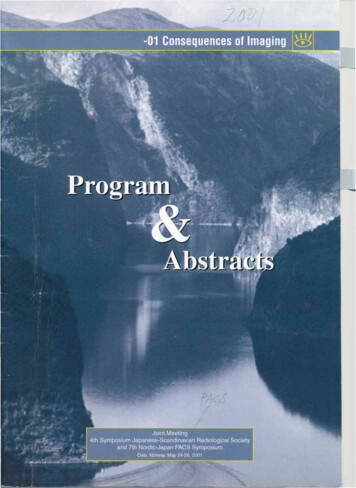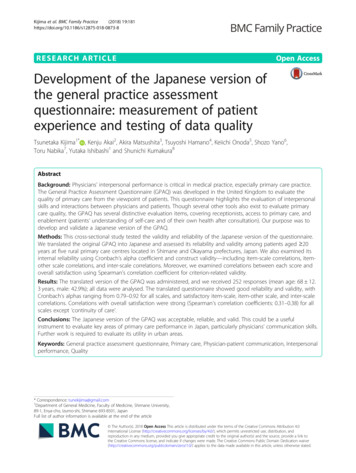
Transcription
Kijima et al. BMC Family Practice(2018) EARCH ARTICLEOpen AccessDevelopment of the Japanese version ofthe general practice assessmentquestionnaire: measurement of patientexperience and testing of data qualityTsunetaka Kijima1* , Kenju Akai2, Akira Matsushita3, Tsuyoshi Hamano4, Keiichi Onoda5, Shozo Yano6,Toru Nabika7, Yutaka Ishibashi1 and Shunichi Kumakura8AbstractBackground: Physicians’ interpersonal performance is critical in medical practice, especially primary care practice.The General Practice Assessment Questionnaire (GPAQ) was developed in the United Kingdom to evaluate thequality of primary care from the viewpoint of patients. This questionnaire highlights the evaluation of interpersonalskills and interactions between physicians and patients. Though several other tools also exist to evaluate primarycare quality, the GPAQ has several distinctive evaluation items, covering receptionists, access to primary care, andenablement (patients’ understanding of self-care and of their own health after consultation). Our purpose was todevelop and validate a Japanese version of the GPAQ.Methods: This cross-sectional study tested the validity and reliability of the Japanese version of the questionnaire.We translated the original GPAQ into Japanese and assessed its reliability and validity among patients aged 20years at five rural primary care centres located in Shimane and Okayama prefectures, Japan. We also examined itsinternal reliability using Cronbach’s alpha coefficient and construct validity—including item-scale correlations, itemother scale correlations, and inter-scale correlations. Moreover, we examined correlations between each score andoverall satisfaction using Spearman’s correlation coefficient for criterion-related validity.Results: The translated version of the GPAQ was administered, and we received 252 responses (mean age: 68 12.3 years, male: 42.9%); all data were analysed. The translated questionnaire showed good reliability and validity, withCronbach’s alphas ranging from 0.79–0.92 for all scales, and satisfactory item-scale, item-other scale, and inter-scalecorrelations. Correlations with overall satisfaction were strong (Spearman’s correlation coefficients: 0.31–0.38) for allscales except ‘continuity of care’.Conclusions: The Japanese version of the GPAQ was acceptable, reliable, and valid. This could be a usefulinstrument to evaluate key areas of primary care performance in Japan, particularly physicians’ communication skills.Further work is required to evaluate its utility in urban areas.Keywords: General practice assessment questionnaire, Primary care, Physician-patient communication, Interpersonalperformance, Quality* Correspondence: tunekijima@gmail.com1Department of General Medicine, Faculty of Medicine, Shimane University,89-1, Enya-cho, Izumo-shi, Shimane 693-8501, JapanFull list of author information is available at the end of the article The Author(s). 2018 Open Access This article is distributed under the terms of the Creative Commons Attribution 4.0International License (http://creativecommons.org/licenses/by/4.0/), which permits unrestricted use, distribution, andreproduction in any medium, provided you give appropriate credit to the original author(s) and the source, provide a link tothe Creative Commons license, and indicate if changes were made. The Creative Commons Public Domain Dedication o/1.0/) applies to the data made available in this article, unless otherwise stated.
Kijima et al. BMC Family Practice(2018) 19:181BackgroundImproving the quality of medical care is a high priority inJapan, as well as in other countries. There are many toolsworldwide for evaluating the quality of primary care, including the Components of Primary Care Index [1], Primary Care Assessment Survey (PCAS) [2, 3], Primary CareAssessment Tool (PCAT) [4], EUROPEP questionnaire [5],General Practice Assessment Survey (GPAS) [6, 7], andGeneral Practice Assessment Questionnaire (GPAQ) [8].Among these tools, the GPAQ, was originally developed inthe United States as the PCAS; then, in collaboration withthe Health Institute in Boston and the National PrimaryCare Research and Development Centre at the Universityof Manchester, in the United Kingdom, it was modified foruse in British general practice and became the GPAS, whichhas been widely used [3, 6, 7, 9]. A brief version of theGPAS (the GPAQ) was also used for increased accessibilityto patients and with a revised scoring system [8]. TheGPAQ has been broadly used as a quality survey for generalpractice and has been translated into and validated in manylanguages, including Chinese, Somali, and Thai [10–12].The goal of this questionnaire is to evaluate various aspectsof care quality, such as receptionists’ demeanour, access toprimary care, continuity of care, physicians’ communicationskills, and enablement (understanding of self-care and ofone’s own health after consultation).It has been noted that effective communication skillsamong physicians are critical for patients to developtrust in them [13]. Factors such as maintaining confidentiality, respecting patients’ dignity, and involving them intreatment decisions are also highly valued [14]. Inaddition, systematic patient feedback about physicians’interpersonal skills has been shown to help improvephysicians’ interpersonal performance [14, 15]. Thus, theGPAQ is used to assess how patients feel about their primary care and how they cope with their problems or illnesses during and after consultations, making it anenablement scale [16].In Japan, however, no study has used the GPAQ in primary care; instead, a Japanese version of the PCAT(JPCAT) has been developed and used [17]. Previousstudies using the JPCAT have reported that patients’ experience in primary care affects their health-associatedbehaviour or ability in Japan. Patient experience of primary care was positively related to breast cancer screening uptake in Japanese women [18], while longitudinalityand comprehensiveness of primary care service were related to higher health literacy [19]. On the other hand,Japanese family physicians (FPs) and general practitioners (GPs) require additional education. An Organisation for Economic Co-operation and Development(OECD) review noted that Japanese primary care hasbeen provided by a cadre of semi-generalists/semi-specialists, those who were working as generalists in thePage 2 of 11community with an unspecified amount of time to trainas generalists (no compulsory further training) after theyhad left hospital practice [20]. Therefore, the former Japanese Academy of Family Medicine (JAFM) (currentlythe Japan Primary Care Association (JPCA)) started thecertification system of a residency training programmefor FPs in 2006 [21]. Moreover, The Japanese MedicalSpecialty Board established primary care as a distinctnew medical specialty beginning in 2018 [22]. Patients inEuropean countries are generally provided consultationby GPs who completed specialist training in familymedicine, and some of those countries have a system forregistering patients for primary care [23]. A registrationsystem with a primary care practitioner is suggested topossibly bring more effective primary care such as providing lifestyle advise, coordinating an individual’s care,and strengthening the relationship between patients andtheir primary care physicians [23]. There is no suchregistration system in Japan; however, Japan’s medicalsystem is gradually beginning to recognise primary carephysicians as medical specialists. For example the Japanese Medical Specialty Board recognised family medicine as a new specialty in 2017 [22]. The GPAQ is a toolto assess physicians’ interpersonal skills; thus, we expected its results to be useful not only for improving thequality of care but for educating new FPs/GPs.Compared with the PCAT, the GPAQ features a moredetailed evaluation of practitioners’ interpersonal andcommunication skills in relation to patients. To take advantage of this affordance, we focused on the development and validation of a Japanese version of the tool(GPAQ-J). To verify the robustness of the GPAQ-J, wealso referred to the results of the JPCAT, an establishedprimary care assessment tool.Thus, the purpose of the current study was to developthe GPAQ-J, a self-administered questionnaire, from theoriginal GPAQ, using a formatted translation process, andto conduct a full validation survey. We established theutility of this new tool through statistical analyses. We alsoanalysed responses to questionnaire items on physicians’interpersonal skills in their practice. The results elucidatethe characteristics of Japanese primary care and show thedifferences between this new tool and an existing alternative—the JPCAT—for the Japanese context.MethodsDesign and development of the GPAQ-JFirst, we conducted a cross-sectional study to develop theitems of the GPAQ-J; then we examined the validity andreliability of this questionnaire. Next, we compared theGPAQ-J with the JPCAT. The process included sevensteps, following previous studies [10, 17, 24]. To capturecultural differences, those studies conducted qualitative aswell as quantitative assessments [10, 17, 24]. Qualitative
Kijima et al. BMC Family Practice(2018) 19:181methods improve the contents of a questionnaire usingcomments offered by non-expert and expert panels. Wemodified sentences or added items using participants’ideas and adapted or eliminated items based on quantitative assessment, which incorporated focus groups and theDelphi method. The Delphi method assesses quantitativeinference using qualitative methods and was used to review the expert opinions. In the original Delphi method,the process creates a list to review such as a detailed literature review or a list of diagnostic criteria [25]; however, westarted by reviewing the translated questionnaire withoutthe formal process of creating a list; hence, our processused a modified Delphi method. The procedure was as follows: 1) researchers selected appropriate participants andsent them the questionnaire; 2) participants evaluated theappropriateness of the questionnaire and provided comments; 3) researchers judged participants’ responses andmodified the items accordingly; 4) researchers sent participants the results of the assessment and the revised questionnaire; and 5) participants assessed the revisedquestionnaire and offered comments again. This procedure was repeated until a consensus was reached. A focusgroup was also conducted to review and improve the instrument’s content. For qualitative analysis, in Steps 2 and3, two analysts—a primary care physician and a healthcare research expert—analysed the results.Step 1. Forward translation: Two native Japanese professional Japanese–English translators independentlytranslated the GPAQ into Japanese. Each had clinical experience in a Japanese medical field and more than eightyears of translation experience. Subsequently, anotherexpert translator synthesized the two versions into one.Step 2. Qualitative review (medical expert panel): The developers of the GPAQ-J, who were primary care experts,examined its clarity, accuracy, and adequacy by conductinga review using a modified Delphi method [25]. The developers were 12 primary care experts from four professions(three from each profession): primary care physicians whowere JPCA-certified FPs, community-health centre directors, healthcare research experts, and experienced primarycare nurses who were trained in family medicine or experienced family-medicine nurse supervisors. They evaluatedthe necessity of each item using a nine-point scale and werealso asked about necessary revisions and additions. Theconsensus was judged based on a rating score; a perfect orvery good score implied consensus [26]. ‘Perfect’ referred towhen all responses ranged from 7 to 9. ‘Very good’ meantthat 80% of the responses ranged from 7 to 9 and 80% werewithin two integers of the median. Participants’ commentswere also used to revise, remove, or add items. Threerounds were conducted until a consensus was reached.Step 3. Qualitative review (non-medical panel): Afocus group was conducted with 10 participants fromoutside the medical profession to ensure that thePage 3 of 11questionnaire was easy to understand and used commonlanguage. The participants were instructed to checkwhether items were culturally valid and useful, flagtroublesome items, and propose alternatives.Step 4. Back translation: Following previous studies[17, 24], a back translation of the GPAQ-J was conducted by a native-English-speaking writer and translator who had lived in Japan for more than 10 years.Step 5. Expert review: The health research experts andthe forward and back translators jointly reviewed allitems, discussed whether they were appropriately translated, and raised any concerns. Finally, the questionnairewas adjusted to the most appropriate items, which participants had agreed upon through the expert review.Step 6. Pilot testing: A pilot test was conducted with35 patients in three local primary care centres in Japan;then, final revisions were performed.Step 7. Full validation study: Participants included Japanese patients aged 20 years who had ever undergoneconsultation at a primary care centre. A research assistant informed participants of the purpose and content ofthe study with an explanation form. A returned, completed questionnaire was considered consent to participate in this study. Japanese patients were defined asthose living in Japan who could adequately understandJapanese. Japanese primary care physicians’ training differs from those in other OECD countries [20]; therefore,it took time to establish a FP/GP training system inJapan. Until JAFM started the residency trainingprogramme for FPs in 2006 [21], there was no standardised training system for primary care physicians inJapan. Patients’ experiences largely depended on the individual physician’s career. For the validation study, wetargeted respondents with similar patient experiences tominimize variation in the data; the experience of patientsseeing physicians who had just left hospital practicewould differ from that of patients seeing physicianstrained in family medicine. Hence, we focused on theprimary care centres where physicians who had been educated or trained in family medicine provided primarycare. For this study we defined a primary care centre asa facility specialising in family medicine practice withthe qualifications for residency training; specifically, thepractice had to have one or more certified FPs holding adiploma in primary care from the JPCA. A previousstudy also noted that patients’ experience or satisfactiondepended on the location of the healthcare facility—inparticular whether it was in a rural or an urban area[27]. Therefore, we collected data by restricting ourselves to experiences in rural primary care centres. Arural area was defined as a region with a populationdensity lower than the national average in Japan (approximately 343 people per km2) [28]. Finally, we selected five primary care centres located in Shimane and
Kijima et al. BMC Family Practice(2018) 19:181Page 4 of 11Okayama prefectures where the mean population densitywas approximately 122 people per km2.Ultimately, the GPAQ-J contained six sets of questionsto assess the quality of primary care: frequency of visits(item 1), helpfulness of receptionists (item 2), access tocare (items 3–5), continuity of care (item 6), doctors’communication skills (item 7), enablement (item 8),demographic data (items 9–12), and general comments(item 13). Demographic data gathered included age, sex,employment, and health status. Overall satisfaction withprimary care (1 very dissatisfied, 3 neutral, and 5 very satisfied) was also assessed.We had concerns about the evaluation of patient satisfaction using the GPAQ-J, because it was self-administered,completed at the health centre, contained patients’ demographic information, and included sensitive questions abouttheir physicians’ communication skills which theyresponded to just after the consultation. Therefore, theJPCAT was also administered at the same medical facilitiesduring the same period. However, to reduce the burden(particularly for the elderly), this instrument was given tosome of the same sample of patients as the GPAQ-J. Onthe JPCAT, patients’ demographic data were not recorded,because the original questionnaire did not include thosedata. Additionally, we intended to compare patients’ satisfaction ratings between the two scales to confirm whetherpatients had overestimated their satisfaction on theGPAQ-J; previous studies have found that demographicquestions can affect survey measurements and that sensitivedata are likely to be misreported when demographic dataare also collected [29, 30]. Respondents were given smallgifts of gratitude worth JPY 300 (approximately 3 USD).This study was approved by the Shimane University Institutional Committee on Ethics (approval number: 2763).item-scale correlations were assessed by calculating therange of correlations obtained for all items in a scale, andwe defined an acceptable narrow range as 0.2 [32, 33].Discriminant validity was assessed using item-other scalescorrelations. If the correlation between an item and thehypothesised scale was significantly greater than the correlations between the item and all the other scales,item-discriminant validity was confirmed [35, 36]. A scaling success rate was also calculated [32, 37]. Inter-scalecorrelations were used to assess construct validity [6, 38]and evaluate how distinct the items between and withinscales are; if inter-scale correlations are lower than internal reliability measures (Cronbach’s alpha), each scalemeasures a unique concept [39, 40]. Moreover, we examined correlations between each scale/item and overall satisfaction using Spearman’s correlation coefficient forcriterion-related validity, and defined correlations 0.30as meaningful [41].Fourth, we assessed the dimensional structure of theGPAQ-J using principal component analysis. The aim wasto explore a smaller number of hypothetical factors withinmultiple observed factors. We initially identified the number of factors by examining a scree plot. Next, we performed a full principal axis factor analysis based on thisnumber of factors. Furthermore, a varimax rotation procedure was conducted to produce the solutions and uncorrelated factors. This procedure is similar to previousfactor analyses of the original GPAS and GPAQ [8, 9].Finally, we analysed the collected data following theJPCAT method [17, 42]. We assessed overall satisfactionand its correlation with each scale of the JPCAT to determine the external validity of the GPAQ-J. All statistical analyses were carried out using JMP Pro 12 (SASInstitute Inc., Cary, NC, USA).Statistical analysesResultsWe developed the GPAQ-J through the seven steps described above. Patients (N 252) responded to theGPAQ-J (approximately 50 participants per clinic). Respondents were Japanese patients who had visited any ofthe five target primary care centres from May to July2017. These respondents accounted for approximately6.7 2.1% of outpatients aged 20 years in each clinic.Patients (N 234) also responded to the JPCAT at thesame clinics during the same period; however, 19 didnot identify a primary care provider. Therefore, 215 responses were included in the final analyses.The process of the expert review and pilot test are inAdditional file 1. The item ‘Waiting time at the practicefor each consultation’ required revision in Steps 2 and 3.In addition, items about patients wanting to see a particular physician/any physician and about urgent consultations were removed in Step 2. Additionally, we addeda question in Step 2, and revised it in Steps 3 and 4,First, we assessed each item and defined missing data as
Compared with the PCAT, the GPAQ features a more detailed evaluation of practitioners’ interpersonal and communication skills in relation to patients. To take ad-vantage of this affordance, we focused on the d
